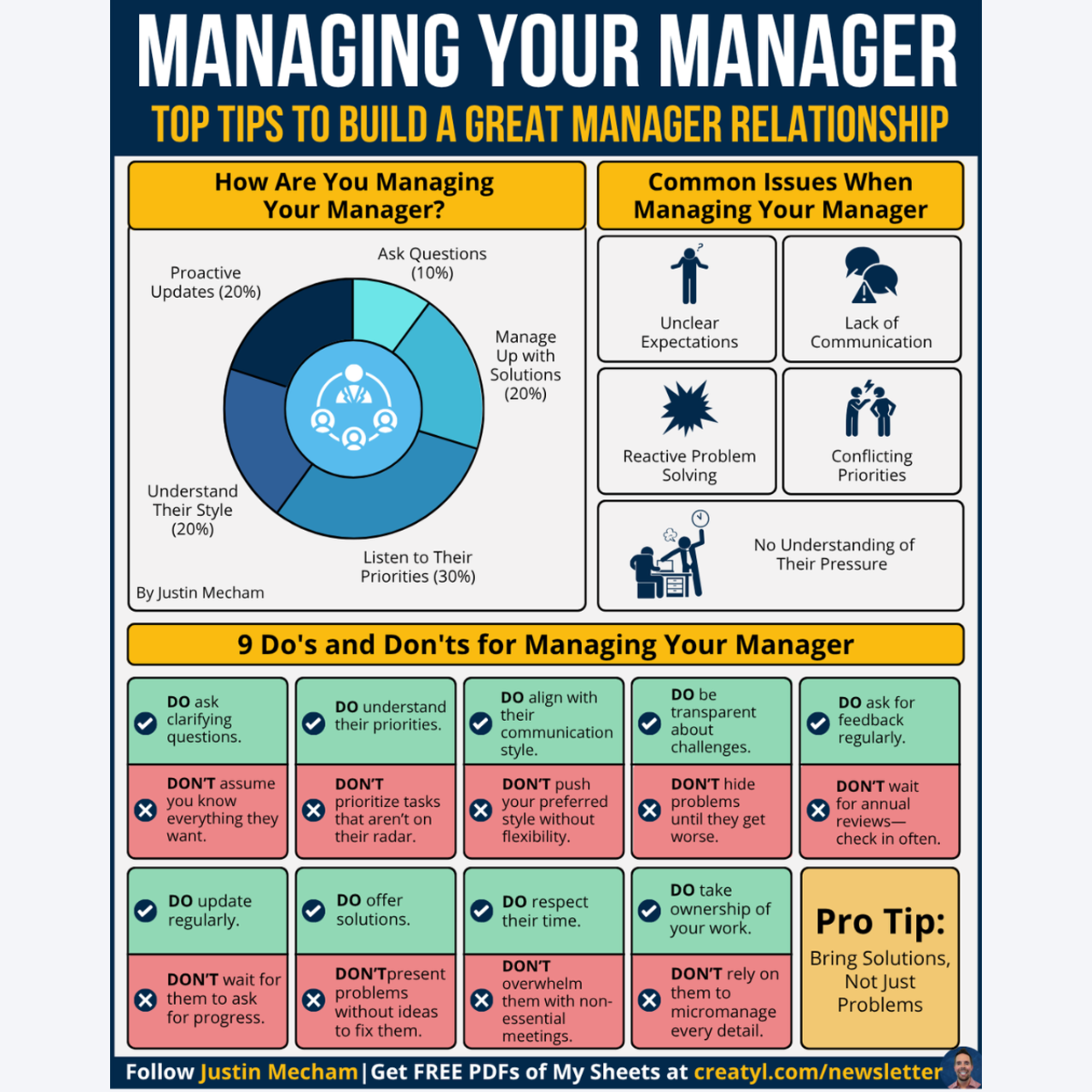If You Want Today's PDF, Click Here.
Most of us think about management as steering others.
We're taught to focus on our deliverables, follow our manager's directions, and let hierarchy sort itself out.
But there's a parallel skill—one that’s rarely discussed but deeply noticed. It’s the ability to manage your manager.
In other words, go beyond just doing your job.
Be proactive in shaping how your manager experiences your work, your challenges, and your alignment with their priorities.
That shift not only reduces their stress—it demonstrates your reliability in a way words never could.
Why Managing Up Should Matter to You
Every manager carries unseen weight: expectations from senior leaders, shifting priorities, team needs, and deadlines they can’t always control.
They don’t always say exactly what they want or when, leaving room for missed alignment.
That gap between what they expect and what they clearly communicate is where most workplace breakdowns happen.
If you know how to read between the lines, anticipate needs, and communicate with clarity, you don’t just deliver work—you prevent crisis.
You become the person your manager trusts without hounding their calendar.
From Missed Deadlines to Rock-Solid Trust
A marketing team I worked with was missing big campaign milestones.
They assumed alerts should wait until full clarity.
They didn’t want to bother the manager with partial updates.
That meant small problems festered until they became major delays.
Upcoming launches were derailed. The manager was frustrated. Team morale dropped. And trust started to crumble.
Here’s the four-step fix we built:
1. Structured Weekly Updates
Every Monday, the team emailed a one-page summary: tasks tied to the manager’s top goals.
Every Friday, a recap: what shipped, what delayed, and—crucially—two alternative solutions for any roadblock. Managers got visibility without follow-up needed.
2. Questions Framed as Options
Instead of asking: “What’s your preferred deadline?” they asked:
“Would you prefer I turn in the final draft Tuesday, or after your edits on Thursday?”
That simple shift allowed instant clarity, no long back-and-forth.
3. Matching Communication Style
I observed the manager scanned Slack faster than long emails.
So the team switched to brief bullet points with clear headlines. No fluff. Quick clarity.
4. Presenting Problems With Solutions
When a vendor delay threatened a launch, the team didn’t just say: “We're stuck.” They wrote:
- Option A: Hire a temporary designer to keep the timeline, at extra cost
- Option B: Delay launch by two days, cost-free
The manager could act promptly—and confidently.
How the Team Changed Results (Fast)
Within two months:
- Every deadline was met.
- The manager began trusting the team to anticipate challenges.
- Morale improved as friction disappeared.
- The team became known as internal partners, not just doers.
They went from being invisible risks to rock-solid support.
Core Practices That Drive Real Change
From that coaching experience—and many others—these four skills consistently delivered results:
- Proactive Communication
- Don’t wait to be asked. Share updates early and often to stop surprises.
- Clear, Choice-Based Questions
- Always frame requests so your manager has clear options. It simplifies their decision-making.
- Alignment on Priorities & Style
- Understand what matters most to your manager—and how they prefer to receive information.
- Solution-Oriented Thinking
- Present issues with at least one or two potential fixes. It shows ownership and respect for their time.
The Barriers Most People Face—and How to Overcome Them
Fear of overstepping.
A sense that managing up is not “your job.”
Avoiding conversations because they feel uncomfortable.
Waiting too long to ask for direction.
These mindsets undermine your development—and create more work for your manager.
Silence and delay build misaligned efforts, wasted time, and frustration for both of you.
In contrast, approaching the role as a partner—not just an employee—builds clarity, trust, and long-term value.
Recommended Tools & Media
Want to sharpen these skills further? These are highly-rated, widely praised tools that deliver on messaging, mindset, and real-world insight:
- Book: Managing Up: How to Get What You Need from the People in Charge by Melody Wilding – A modern, hands-on guide focused on understanding your boss’s world and influencing effectively.
- TV Show: Undercover Boss (US series) – Elite executives go undercover among their own team members. An emotional peek into communication gaps, hidden needs, and the power of insight from ground-level perspective.
- TED Talk: Stop Managing, Start Leading by Hamza Khan – A powerful mindset shift that reframes ownership: act with initiative, regardless of title.
What This Skill Really Means to Your Career
Building Clarity and Confidence Together
This skill isn’t about doing more tasks—it’s about creating clarity and confidence for both you and your manager. It shows you're inside the pressure, not behind it.
When You Act Early, Ask Smart, and Offer Ideas, you change how others experience your work—and how they see you.
You Stop Being the Unknown Risk.
Instead, you become the person they count on.
That shift changes everything.
They begin to trust not just what you deliver, but how you think. And when that trust grows, so does your career.
Download the Infographic
Keep this framework handy. Download the full Managing Your Manager infographic as a PDF so you can consult it anytime.





